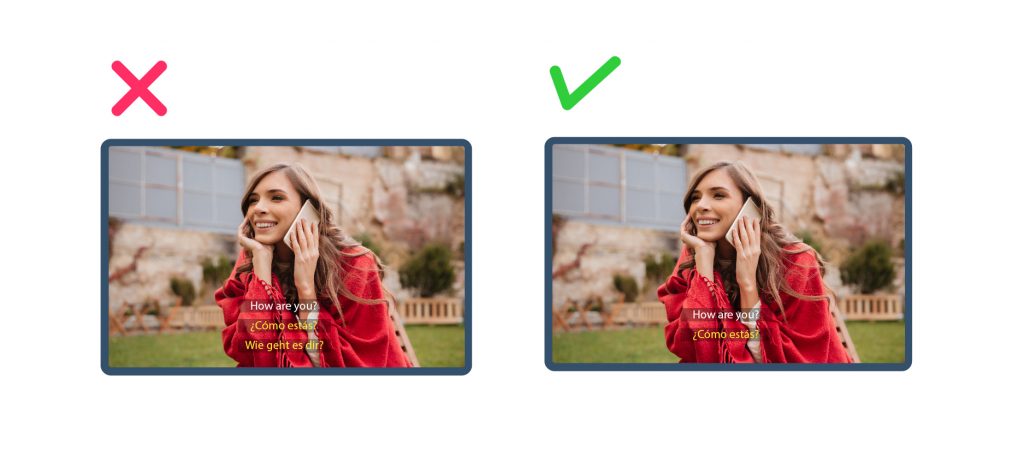The return-on-investment (ROI) of multilingual subtitling has always been a topic of debate for brands and marketers. However, many brands have employed subtitles to increase the reach of their audio and video content.
In 2013-14, Discovery Digital Networks ran an experiment for 16 months to determine the change in ROI between videos with captions and those without them. Within two weeks of adding closed captions, there was a 13.48% increase in views, as well as a lifetime increase in views at 7.32%.
Subtitles increase the accessibility of your content while also enabling the audience to consume video content on ‘mute.’ Let’s take this a step further and talk about multi-language subtitles. What do you do when you wish to display subtitles for more than one language?
Multi-language Subtitles vs Multilingual Subtitles
These terms are often confused and used in the wrong context. Multi-language subtitles refer to the practice of displaying subtitles in more than one language simultaneously. While multilingual subtitles refer to subtitles in more than one language (not displayed simultaneously) and subtitles of visual content, which originally includes the use of multiple languages.
Say, if you decided to display subtitles for two languages – Spanish and German – in your video, that would be called multi-language subtitling. If you decided to get an expert for adding subtitles in English and your video has speakers or characters talking in Spanish, German, and Danish, that would be called multilingual subtitling.
The Scope of Multi-Language Subtitles
While it may seem like the need for adding subtitles for two or more languages is rare, brands have come to use these now, more than ever. Multi-language subtitles are of great use when your audience or participants (of an event) comprise people from different geographical and linguistic backgrounds. Such a diverse set of people typically appear in the following situations:
Global meets
Whether it’s a global business organising their annual meet for all their employees or leaders of an industry getting together to share their insights, global events have a large gathering of people coming from various countries and speaking different languages. While the speakers talk in one language (one spoken by the majority), adding multi-language subtitles to presentations and videos will help the entire audience engage with speaker(s) actively.
Online events (webinars, live talks, etc.)
The COVID-19 pandemic forced brands and influencers to bring all their events online. Consequently, people who might not have been able to travel to the venue and attend the event offline were able to do so now since it just requires them to connect from their homes. This change encouraged a diverse set of participants who communicate in different languages.
In-store visual content (advertisements, announcements, etc.)
If your store is located in a multilingual locale, subtitling the videos you display inside the store will be a great way to attract potential customers. Delivering information in their native languages will increase foot traffic in the store. Also, in countries like Canada, where there are two official languages (English and French), you are required to share all information – marketing or otherwise – in these two languages.
Best Practices for Using Multi-Language Subtitles
Adding multi-language subtitles to your videos requires to keep the following things in mind:
Add subtitles for only two languages
Adding two different subtitles to your video takes up a substantial amount of space, per frame. This causes readability issues for the viewers as they desperately try to find the subtitle for their language and read it before the frame changes. So, you must ensure that you add only two languages to your videos.

In case your audience comprises people speaking many different languages, do a little research before the event or before creating your marketing videos. You can even run a poll to determine the two languages spoken by the majority and create subtitles accordingly.
Keep the time-coded source text short
This is a general rule applicable to all kinds of subtitles – the shorter the subtitles in each frame, the easier it is to read them. However, this rule is especially important for multi-language subtitles. Ensure that the subtitle for each language doesn’t run into more than one line per frame.

The best way to avoid any readability issue is to keep the source text short. When you transcribe your video (with time codes) in its original language, keep the length of the subtitles to a minimum. This will make it easier for the subtitling expert to translate without reducing a lot of text.
Pick a font colour for each language
Finding the right subtitle and reading it in a limited time is in itself a difficult task for the viewer. So, you must try to make it as effortless as possible.

One way is, to choose a font colour or background colour for each language. This will save the viewer the hassle of finding the right subtitles every time the frame changes. This practice is necessary when displaying subtitles for languages that look/read similar, for instance, Arabic and Urdu.
Burn the subtitles to the video
For multi-language subtitles, correct formatting is of utmost importance. Without it, you run the risk of ruining the viewers’ visual experience. When you don’t burn subtitles to your online live event or webinar, you leave it to the viewers to adjust the formatting (based on their player and browser settings). It might lead to issues like an increased font size that does not fit in the frame or a right-to-left language displayed incorrectly.
So, it is wise to burn the subtitles to the video to avoid such issues while viewing.
Conclusion
Multi-language subtitles work best for audiences who are viewing your videos in real-time. They increase your videos’ reach and enable a diverse set of people to engage with your content. Keeping the above-mentioned practices in mind will help your brand in making the best of these subtitles.
Did we miss any best practice used for subtitles? Please let us know in the comments.


